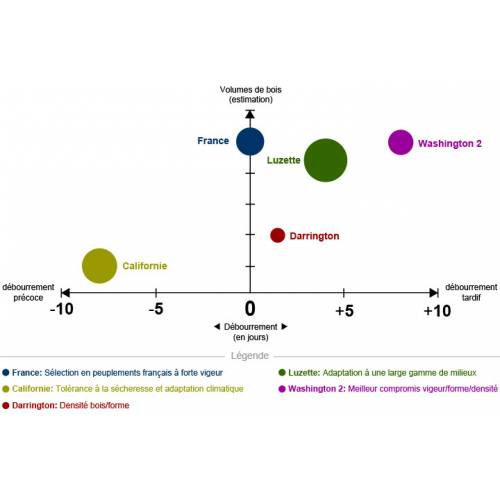
Douglas Fir Forestry
The genetic improvement of the Douglas Fir
- Details
-
Reforestation variety used in large quantity in France nowadays, the Douglas has been the subject of constant efforts from research organisations (INRA, CEMAGREF, FCBA) in order to improve the quality of the reproduction material made available to the foresters.
This effort is materialised, notably, by the setting up of 95 hectares of seeds orchards made up from trees coming originally from France and America, The origin's choice has been made in order to improve, particularly the following characteristics: the adaptability, the growth, the straightness and the branching (thickness, angle, number).
These seeds' orchards are, from now on, in a production phase and complete offers from specialised seeds sellers, Research programs are continuing and have for main objectives setting up new orchards of second generation's seeds which will allow the production of quality seeds in particular regarding the inherent characteristics of the material.
How do we create a new variety of Douglas Fir?
The improvement principle is in itself very simple: trees are selected, multiplied using grafting or taking plant cuttings and they are placed in specialised growing farms with the objective of producing seeds: Seeds' orchards, In the fifties, measures of origins comparisons have been set up in France with seeds of commercial origin.
It is only in the seventies that a collection of origins covering the entire natural areas has been set up on the ground by the INRA and the FCBA, The INRA and the FCBA have also been interested by the French varieties and have collected their seeds.
The setting up of these field experiments constitute the first step of the genetic improvement, They have allowed better knowledge of the best provenance areas and to select the trees which have been planted in the seeds' orchards (orchard Luzette, Orchard France...).
Since 2011 the importation of seeds coming from their natural habitat is no longer possible: all the seeds used at the moment in France are therefore harvested in the seeds' orchards.
Douglas' seeds orchards of the future?
The INRA, FCBA and the ONF have set up, with the support of the Agriculture Ministry, the project «Douglas future». There is a dual objective:
- Select in this field experiments network a few hundred of trees which will make up an improved population (the equivalent in a way of a «genes bank»),
- Set up in a few years one or several new seeds' orchards.
The trees selection's criteria will be defined in consultation with professionals. No doubt, compromises will have to be made as some characteristics have adverse links: the branches abundance is for example linked to the growth. One must note that taking into account climate changes, fields experiment set up in the South of France with suitable trees of American origins will be studied in order to select the trees which will show drought and heatstroke's resistance. Grafted plants must be grown in nurseries during two years before being planted in the seeds' orchards. Then we will have to wait about 10 years for the trees to have developed sufficiently: then it will be possible to induce fructification by a partial girdling of the bark.
Results of the genetic improvement of the Douglas Fir:
We can today distinguish 5 different improved forestry materials, on the basis of measured or estimated criteria, and this according to our best actual knowledge.
This differentiation rest on 3 criteria, which can be seen on the graph shown below and which are the following:
- The lateness of bud break in the spring (horizontal axis) measured compared with an historical witness (Washington 403).
- The volume expected from the wood produced, directly correlated with height growth (vertical axis).
- The genetic diversity which shows the capacity to adapt to the different hazards which can take place after planting.
cf fotograph
Genetic benefits according to provenance:
PROVENANCE GENETIC BENEFIT Darrington (PME-SO-001) - Excellent shape : straightness of the trunk, branching, ramification
- medium growth
- relatively late bud breakingLa Luzette (PME-SO-002) - Good shape : straightness, Great vigour when young
- Late bud breakingWashington 2 (PME-SO-005) - Good shape exceptional vigour
- the latest bud breaking in the French seeds' orchardsWashington (PME-SO003) - Bud breaking and growth's dates close to the seeds' orchard dates of "La Luzette"
- The other criteria are in the process of being analysed
- Good vigour
- Late bud breakingFrance (PME-SO-004/007/008) - Good vigour
- Late bud breakingCalifornia (PME-SO-006) - Good shape : straightness of the trunk, no forking and angle of ramification open
- Good vigour
- Please note : Early bud breaking which makes it sensitive to late frost
How to choose your Douglas variety?
cf fotograph
* SO: Seeds' orchards
** Document based on works of the INRA and the Cemagref - Photos (2)


